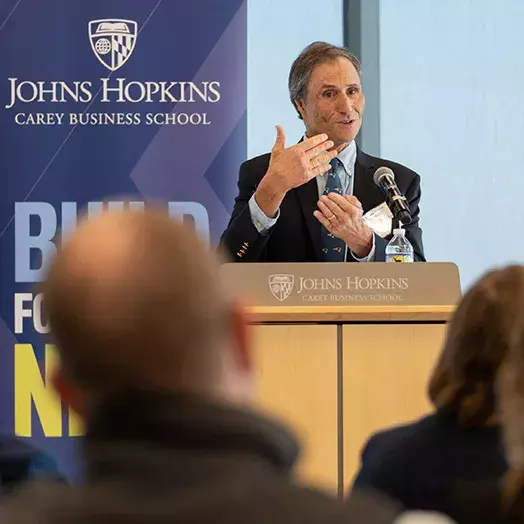David Godes, the Clyde F. and Ruth E. Williams Professor in Business, shares his insights on last night’s Super Bowl LIX advertisements.

Boomers and breakthroughs: Super Bowl LIX ad highlights
Boomers and breakthroughs: Super Bowl LIX ad highlights
They say that the deepest truths about civilizations are found in their cultural artifacts, and there is no more sacred ritual in the American cultural canon than the Super Bowl, which combines our passions for sports, consumerism, and heavily salted foods.
Just as some Super Bowls are more exciting to watch than others, some ads are more effective than others. However, this year, the mix of ads felt significantly different from what we’ve seen in many past years, and these differences are reflective of a number of important current trends in America.
Now, there are many reasons for a brand to run an ad: to engage, to connect, to inform, or to persuade. In most cases, either the brand team is hoping to encourage you to talk about them, to associate their brand with some idea you may not associate them with, to tell you something about the brand you don’t know, or to convince you of something you may not fully believe.
The prototypical Super Bowl ad has traditionally fallen into the first category - engagement. Nothing too heavy, lots of fun, something catchy, and lots of talk about them in the weeks that followed the game. Think: the E*Trade “Talking Babies” ad or the Budweiser “Whassup” ad. But this year, while we could still count on at least a chuckle during breaks from the game, and sometimes a belly laugh, the slate of Super Bowl ads seemed overall just a bit more serious, a little less playful, almost mature. Having said that, one ad that felt like an immediate classic was the Bud Light “Big Men on the Cul de Sac.”
In terms of building brand associations, one thing that really stood out was what seemed like an attempt to associate brands with everyone’s favorite generation: Boomers. Particularly entertaining was Michelob Ultra’s “Hustle” ad in which pickleballers Catherine O’Hara and Willem Defoe defeat not only players half their age but also professional athletes Randy Moss and Sabrina Ionescu, all for the prize of a Michelob Ultra.
We saw the same theme with Martha Stewart’s hip hop moves in Skechers, Weathertech’s Golden Girls-meets-Thelma and Louise ad, and Harrison Ford’s treatise on Freedom for Jeep. It seems there’s a purposeful movement, by some brands at least, to deliver the message that Boomers are ok with us.
What to Read Next

Faculty
New Carey faculty are in the right place, at the right time, to impact the futureWhile automotive ads – which used to represent more than a third of ads in the big game – were almost non-existent this year, there was a decided increase in the share of voice of tech firms. We saw ads from ChatGPT, Google Gemini, T-Mobile/StarLink, GoDaddy, and Salesforce, most of them announcing a new and exciting product or service. It’s hard to escape the impression that this is indicative of the rising presence, and influence, of technology in so many aspects of our lives.
Many Americans, regardless of preferences or party, see our current times as being fraught with difficulties and uncertainties. It has been the case in past years that some brands, at similar moments, would use a forum like the Super Bowl to enunciate to consumers through advertising a point of view on important, often controversial, topics. Highlighting the immigrant story in America, Anheuser-Busch’s 2017 ad “Born the Hard Way” documented the odyssey of a German immigrant named Adolphus Busch to St. Louis where he would meet his future business partner, Eberhard Anheuser. Likewise, Audi aired a really powerful ad in 2018 called “Daughter” in which a father explained his stance on gender pay equality. My sense is that we didn’t see anything quite like that this year. For whatever reason, brands didn’t see a potential ROI associated with public stances on controversial topics.
On the other hand, we most definitely saw some organizations engaging their audience in their inspiring work. Pfizer’s first-ever Super Bowl ad promised they would “knock out” cancer. Novartis made an attention-grabbing appeal for early detection of breast cancer. The NFL itself made a push for varsity flag football. These are all welcome and exciting messages, especially during a game that was anything but.
David Godes, PhD
David Godes holds a Ph.D. and S.M. in Management from the Massachusetts Institute of Technology and a B.S. in Economics from the University of Pennsylvania. He was previously on the faculties of Harvard Business School and the Smith School of Business at the University of Maryland. His teaching experiences include undergraduate, graduate and executive courses ranging from Introduction to Marketing



